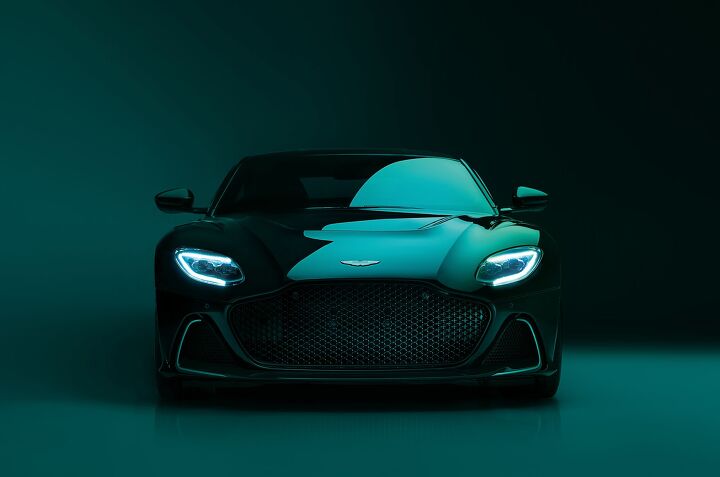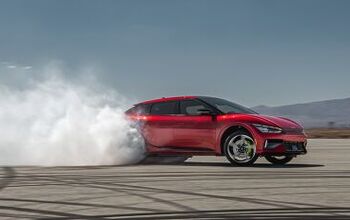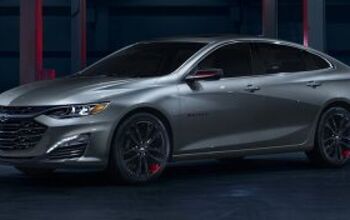Report: Aston Martin Actually Won’t Be Going All Electric

Despite previously having vowed to offer an entirely electric lineup by 2030, Aston Martin has decided to continue selling internal-combustion vehicles beyond the next decade. Company chairman Lawrence Stroll now believes that there will always be demand for combustion engines. Apparently, customers had conveyed to Aston dealers that they still prefer traditional powertrains and want the sensations associated with gasoline-powered automobiles.
Speaking with Autocar, Stroll said he intends for the brand to continue offering liquid-fueled vehicles for as long as governments allow. As things currently stand, the European Union has said it would provide exemptions for boutique manufacturers selling in extremely low volumes after 2035. But Aston Martin already moves too much metal, presumably requiring it to create a specialty subbrand selling a limited number of combustion vehicles each year.
Then again, EV sales aren’t anywhere near the industry or government regulators want them to be. Meanwhile, the public seems fed up with untenable regulatory schemes that are effectively steering the market in ways that don’t really advantage everyday consumers. While this fact hasn’t encouraged Western regulators to change course, it may be making opposition parties favoring deregulation more appetizing to voters.
None of this means Aston is abandoning electrification. While It has decided to delay the launch of its first electric vehicle by two years for a 2027 release date, it’s also increased its EV development budget. However, the company seems like it’s going to shift its focus toward plug-in hybrids — which may allow it to appease regulators while simultaneously satisfying its consumer base.
From Autocar:
Aston Martin has developed a bespoke EV architecture and plans to launch four electric cars on it – a GT, SUV, crossover and ‘mid-engined’ supercar – but they won't hit the market before 2027 after a reveal of the first model in late 2026.
"We have designed and ready one platform to take four different vehicles," Stroll told Autocar. "We have all the products technically engineered and physically designed.
“We planned to launch at the end of 2025 and were ready to do so, but it seems there is a lot more hype in EVs, politically driven or whatever, than consumer demand, particularly at an Aston Martin price point."
He added that demand for electric cars is particularly weak in the luxury segments, as Aston Martins were typically not 'first' cars for their customers and used more for leisure.
Stroll said Aston "will get there" with electric cars, "but at the previously [stated] date, definitely not"
Chairman Stroll made it very clear that he envisions hybrids as the path forward for Aston Martin. But it’s hard for that to mean anything after so many automakers spent the last decade telling the world how they’re on the cusp of a historic shift to totally electrified powertrains. What good is a promise from an industry that (with some exceptions) never seems to mean what it says?
For now, the company plans to focus on hybridizing its V8 powerplants because its customers tend to prefer them over V6s. The first example is supposed to be the mid-engined Valhalla (below) that’s slated to launch later this year. Subsequent models will see comprehensive refreshes the company claimed would include hybridization. Aston Martin believes it can set up vehicles to operate fully electric to traverse city centers that may have restrictions on combustion engines and then swap to hybrids where the gasoline and electric motors work together to maximize performance.
[Images: Aston Martin]
Become a TTAC insider. Get the latest news, features, TTAC takes, and everything else that gets to the truth about cars first by subscribing to our newsletter.
[Images: Aston Martin]

A staunch consumer advocate tracking industry trends and regulation. Before joining TTAC, Matt spent a decade working for marketing and research firms based in NYC. Clients included several of the world’s largest automakers, global tire brands, and aftermarket part suppliers. Dissatisfied with the corporate world and resentful of having to wear suits everyday, he pivoted to writing about cars. Since then, that man has become an ardent supporter of the right-to-repair movement, been interviewed on the auto industry by national radio broadcasts, driven more rental cars than anyone ever should, participated in amateur rallying events, and received the requisite minimum training as sanctioned by the SCCA. Handy with a wrench, Matt grew up surrounded by Detroit auto workers and managed to get a pizza delivery job before he was legally eligible. He later found himself driving box trucks through Manhattan, guaranteeing future sympathy for actual truckers. He continues to conduct research pertaining to the automotive sector as an independent contractor and has since moved back to his native Michigan, closer to where the cars are born. A contrarian, Matt claims to prefer understeer — stating that front and all-wheel drive vehicles cater best to his driving style.
More by Matt Posky
Latest Car Reviews
Read moreLatest Product Reviews
Read moreRecent Comments
- Jeanbaptiste 2022 Tesla model 3 performance ~35000 miles tires - ~$1000ish. Several cabin filters ~$50
- El scotto No rag-top, no rag-top(s) = not a prestigious car brand. Think it through. All of the high-end Germans and Lexus have rag-tops. Corvette is really its own brand.World-leading engines. AMG, M, S and well Lexus is third-world tough. GM makes one of the best V-8s in the world in Bowling Green. But nooooo, noooo, we're GM only Corvettes get Corvette engines. Balderdash! I say. Put Corvette engines in the top-tier Cadillacs. I know GM could make a world-class 3.5 liter V-6 but they don't or won't. In the interior everything that gets touched, including your butt, has to feel good. No exceptions.Some think that those who pay above MSRP and brag about it are idiots. Go the opposite direction, and offer an extended 10-year 100,000-mile factory warranty. At a reasonable price. That's Acura's current business model.
- Carrera 2014 Toyota Corolla with 192,000 miles bought new. Oil changes every 5,000 miles, 1 coolant flush, and a bunch of air filters and in cabin air filters, and wipers. On my 4th set of tires.Original brake pads ( manual transmission), original spark plugs. Nothing else...it's a Toyota. Did most of oil changes either free at Toyota or myself. Also 3 batteries.2022 Acura TLX A-Spec AWD 13,000 miles now but bought new.Two oil changes...2006 Hyundai Elantra gifted from a colleague with 318,000 when I got it, and 335,000 now. It needed some TLC. A set of cheap Chinese tires ($275), AC compressor, evaporator, expansion valve package ( $290) , two TYC headlights $120, one battery ( $95), two oil changes, air filters, Denso alternator ( $185), coolant, and labor for AC job ( $200).
- Mike-NB2 This is a mostly uninformed vote, but I'll go with the Mazda 3 too.I haven't driven a new Civic, so I can't say anything about it, but two weeks ago I had a 2023 Corolla as a rental. While I can understand why so many people buy these, I was surprised at how bad the CVT is. Many rentals I've driven have a CVT and while I know it has one and can tell, they aren't usually too bad. I'd never own a car with a CVT, but I can live with one as a rental. But the Corolla's CVT was terrible. It was like it screamed "CVT!" the whole time. On the highway with cruise control on, I could feel it adjusting to track the set speed. Passing on the highway (two-lane) was risky. The engine isn't under-powered, but the CVT makes it seem that way.A minor complaint is about the steering. It's waaaay over-assisted. At low speeds, it's like a 70s LTD with one-finger effort. Maybe that's deliberate though, given the Corolla's demographic.
- Mike-NB2 2019 Ranger - 30,000 miles / 50,000 km. Nothing but oil changes. Original tires are being replaced a week from Wednesday. (Not all that mileage is on the original A/S tires. I put dedicated winter rims/tires on it every winter.)2024 - Golf R - 1700 miles / 2800 km. Not really broken in yet. Nothing but gas in the tank.



































Comments
Join the conversation
This just in: Aston Martin may avoid insolvency after all.
If this is true then they won't go out of business. Good for them!